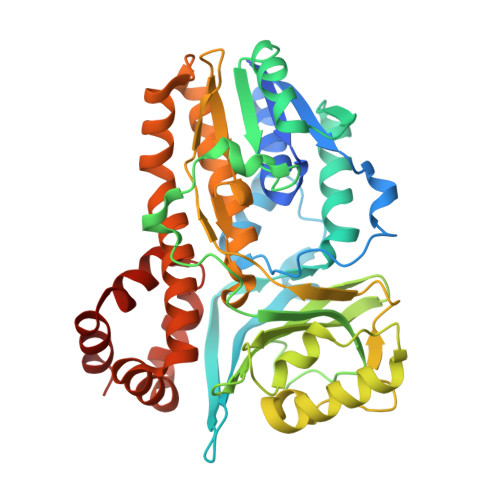Structure and ligand binding properties of the epoxidase component of styrene monooxygenase
Ukaegbu, U.E., Kantz, A., Beaton, M., Gassner, G.T., Rosenzweig, A.C.(2010) Biochemistry 49: 1678-1688
- PubMed: 20055497
- DOI: https://doi.org/10.1021/bi901693u
- Primary Citation of Related Structures:
3IHM - PubMed Abstract:
Styrene monooxygenase (SMO) is a two-component flavoprotein monooxygenase that transforms styrene to styrene oxide in the first step of the styrene catabolic and detoxification pathway of Pseudomonas putida S12. The crystal structure of the N-terminally histidine-tagged epoxidase component of this system, NSMOA, determined to 2.3 A resolution, indicates the enzyme exists as a homodimer in which each monomer forms two distinct domains. The overall architecture is most similar to that of p-hydroxybenzoate hydroxylase (PHBH), although there are some significant differences in secondary structure. Structural comparisons suggest that a large cavity open to the surface forms the FAD binding site. At the base of this pocket is another cavity that likely represents the styrene binding site. Flavin binding and redox equilibria are tightly coupled such that reduced FAD binds apo NSMOA approximately 8000 times more tightly than the oxidized coenzyme. Equilibrium fluorescence and isothermal titration calorimetry data using benzene as a substrate analogue indicate that the oxidized flavin and substrate analogue binding equilibria of NSMOA are linked such that the binding affinity of each is increased by 60-fold when the enzyme is saturated with the other. A much weaker approximately 2-fold positive cooperative interaction is observed for the linked binding equilibria of benzene and reduced FAD. The low affinity of the substrate analogue for the reduced FAD complex of NSMOA is consistent with a preferred reaction order in which flavin reduction and reaction with oxygen precede the binding of styrene, identifying the apoenzyme structure as the key catalytic resting state of NSMOA poised to bind reduced FAD and initiate the oxygen reaction.
Organizational Affiliation:
Department of Biochemistry, Molecular Biology, and Cell Biology, Northwestern University, Evanston, Illinois 60208, USA.














